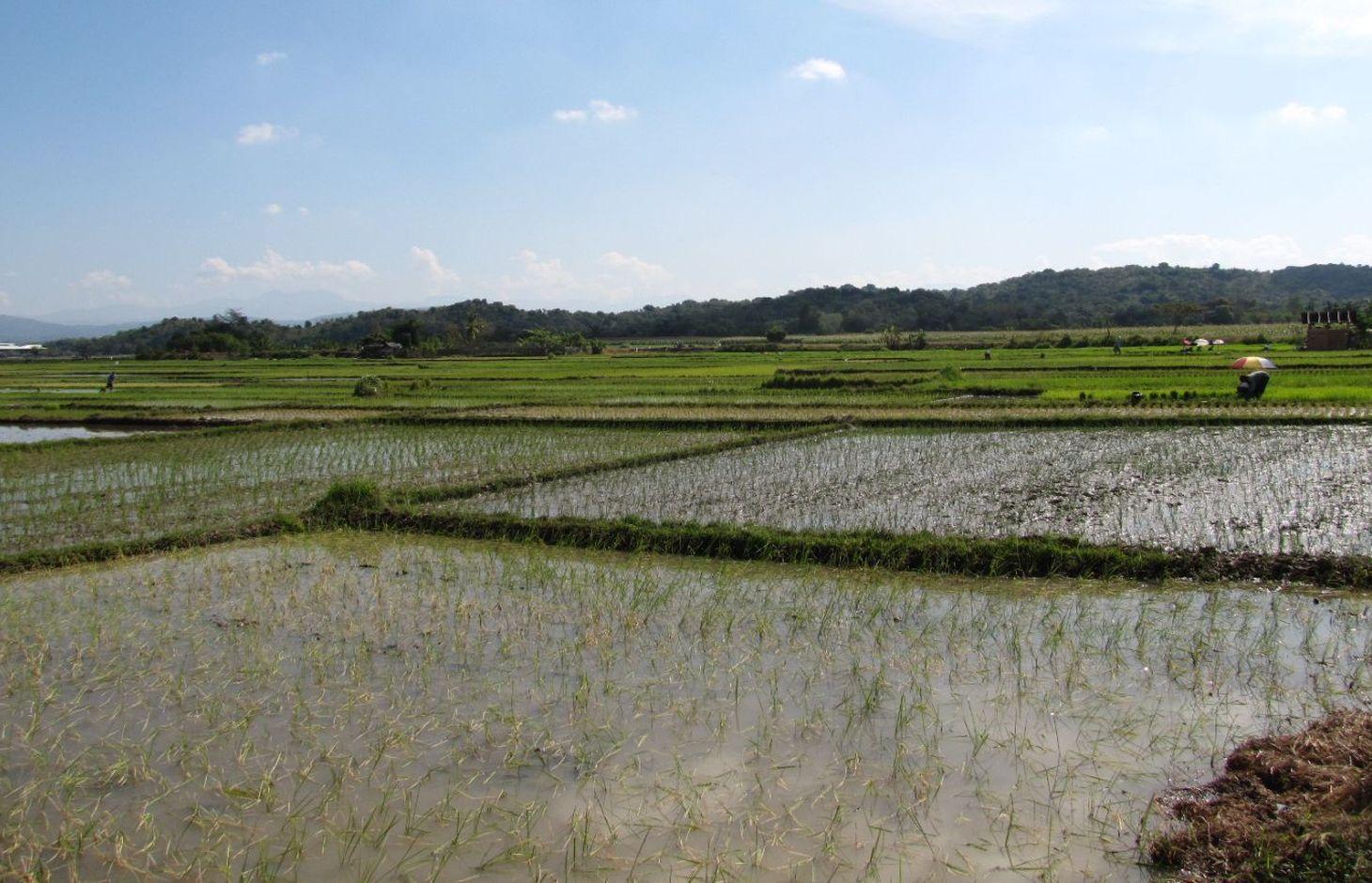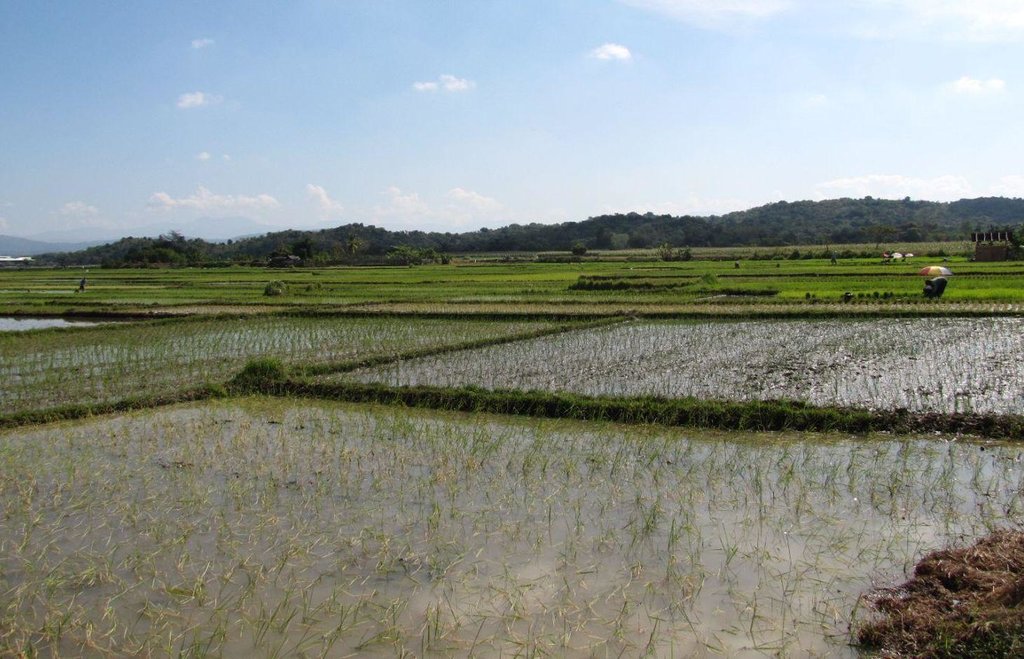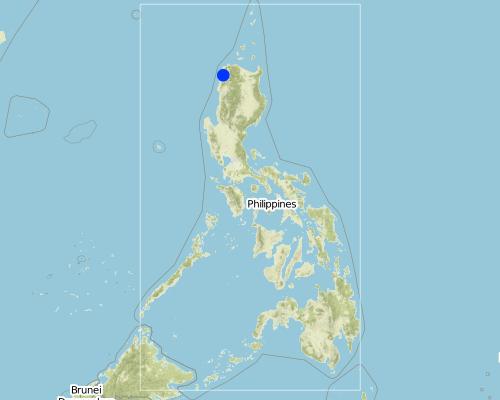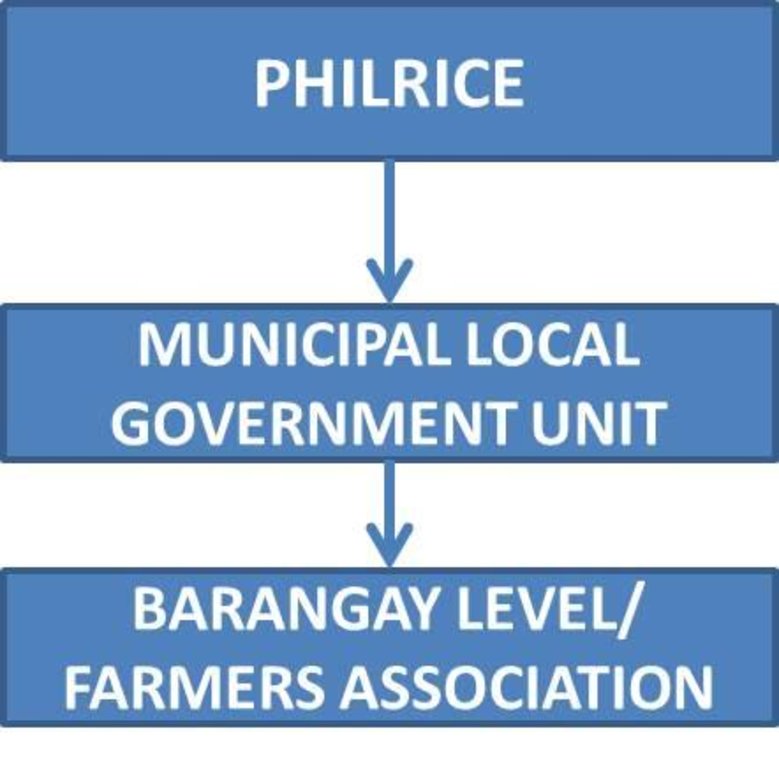Palayamanan: Climate Change Adaptation Strategy for Lowland Ecosystem [Philippines]
- Creation:
- Update:
- Compiler: Philippine Overview of Conservation Approaches and Technologies
- Editor: –
- Reviewer: Deborah Niggli
Palayamanan
approaches_1972 - Philippines
View sections
Expand all Collapse all1. General information
1.2 Contact details of resource persons and institutions involved in the assessment and documentation of the Approach
Key resource person(s)
SLM specialist:
SLM specialist:
Corales Dr.Rizal G.
rg.corales@philrice.gov.ph
Philippine Rice Research Institute
Science City of Munoz
Philippines
SLM specialist:
Baradi Dr. Mary Ann U.
Philippine Rice Research Institute
Batac City
Philippines
Name of project which facilitated the documentation/ evaluation of the Approach (if relevant)
Decision Support for Mainstreaming and Scaling out Sustainable Land Management (GEF-FAO / DS-SLM)Name of the institution(s) which facilitated the documentation/ evaluation of the Approach (if relevant)
Department of Agriculture-Region VIII (DA-8) - Philippines1.3 Conditions regarding the use of data documented through WOCAT
When were the data compiled (in the field)?
10/03/2016
The compiler and key resource person(s) accept the conditions regarding the use of data documented through WOCAT:
Yes
1.4 Reference(s) to Questionnaire(s) on SLM Technologies
2. Description of the SLM Approach
2.1 Short description of the Approach
Synergistic mix of farming ventures implemented by the farm family based on the existing environment and their resources to address food security, income instability, and sustainability.
2.2 Detailed description of the Approach
Detailed description of the Approach:
The objectives of the approach are the following: to improve resources allocation; to enhance biodiversity and ecological balance; to reduce production risks; and to increase cropping intensity, productivity, profitability, and economic stability. It also includes continuous food supply and higher income for land users. With Palayamanan, the farm is not just intended for rice. It is about food security, livelihood and empowering farmers to become better decision makers and resilient to climate change. It also aims to develop land users to become farmer-researchers, extension workers and entrepreneurs.
Methods: Participatory approach with the stakeholders/land users.
Implementation comprised the following stages: (1) Selection of the demonstration sites an farmer-partners; (2) Conduct participatory rapid appraisal on the sites; (3) Planning; (4) Conduct of training for the farmers (Farmers Field School) and for the Agricultural Extension Workers; (5) Establishment of the demonstration farm; (6) Monitoring and Evaluation; and (7) Human Resource Development for Farmers (to become farmer-researcher, extension worker, entrepreneur)
Stakeholders: A. Philippine Rice Research Institute (PhilRice): take the lead in the implementation of the program; facilitate the conduct of training;provide technical assistance to the program; and monitor the progress of the program.
B. Local Government Unit (Agriculture Office): provide support to the activities of the program; spearhead the dissemination and expansion of the program within their concerned municipality.
C. Farmer: participate in various activities of the program from planning to establishment; conduct on-site researches.
The approach introduced a systematized method of farm management involving technologies and practices to utilize available resources without compromising human health and environment. Some of the technologies incorporated under this approach are the following: crop rotation, aquaculture, waste recycling, diversified cropping, alternate wetting and drying, nutrient management, and integrated pest management.
2.3 Photos of the Approach
2.5 Country/ region/ locations where the Approach has been applied
Country:
Philippines
Region/ State/ Province:
San Nicolas, Dingras, Currimao, Ilocos Norte
Map
×2.6 Dates of initiation and termination of the Approach
Indicate year of initiation:
2001
Year of termination (if Approach is no longer applied):
2009
Comments:
Introduced by the Philippine Rice Research Institute (PhilRice)
2.7 Type of Approach
- project/ programme based
2.8 Main aims/ objectives of the Approach
The objectives of the approach are the following: to improve resources allocation; to enhance biodiversity and ecological balance; to reduce production risks; to increase cropping intensity, productivity, profitability, and economic stability. It also includes continuous food supply and higher income for land users. With Palayamanan, the farm is not just intended for rice. It is about food security, livelihood and empowering farmers to become better decision makers and resilient to climate change.It also aims to develop land users to become farmer-researchers, extension workers and entrepreneurs.
2.9 Conditions enabling or hindering implementation of the Technology/ Technologies applied under the Approach
availability/ access to financial resources and services
- enabling
Organized the League of Sangguniang Bayan Chairperson for Agriculture to ensure the source of finance for the expansion areas
institutional setting
- enabling
LGUs were involved and invited during training, seminars and other activities related to the Palayamanan during the implementation to gain their support in the sustainability of the program; Organization of farmers association.
knowledge about SLM, access to technical support
- enabling
capacity building and training such as conduct of Farmers Field School.
3. Participation and roles of stakeholders involved
3.1 Stakeholders involved in the Approach and their roles
- local land users/ local communities
- SLM specialists/ agricultural advisers
- local government
Local Government Unit
3.2 Involvement of local land users/ local communities in the different phases of the Approach
| Involvement of local land users/ local communities | Specify who was involved and describe activities | |
|---|---|---|
| initiation/ motivation | passive | land users were informed about the program through technical briefing/consultation meetings |
| planning | interactive | PhilRice in consultation with the land users and LGUs |
| implementation | interactive | Land users have the option on what technologies they will implement with the technical assistance of PhilRice |
| monitoring/ evaluation | interactive | farm record keeping, testimonial during field day and Palayamanan Congress, land user as correspondent during project monitoring |
| research | interactive | land users developed their own on-site research; they presented the results in a research study paper contest during Palayamanan Congress |
3.3 Flow chart (if available)
Description:
PhilRice introduced and implemented the Palayamanan to one barangay per municipality. The concerned Local Government Unit through its Agriculture Office is responsible to radiate and expand the program to other barangays.
3.4 Decision-making on the selection of SLM Technology/ Technologies
Specify who decided on the selection of the Technology/ Technologies to be implemented:
- mainly land users, supported by SLM specialists
4. Technical support, capacity building, and knowledge management
4.1 Capacity building/ training
Was training provided to land users/ other stakeholders?
Yes
Specify who was trained:
- land users
- field staff/ advisers
- Agricultural Extension Workers
Form of training:
- on-the-job
- farmer-to-farmer
- demonstration areas
- public meetings
Subjects covered:
Farmers Field School (FFS) were conducted to capacitate and inform the land users on various farming technologies (i.e. fertilizer, crop, water, and pest management) and entrepreneurship. Training also incorporated topics on post harvest and farm record keeping. There were also training of trainers (TOT) for farmers on rice production and other crops.
4.2 Advisory service
Do land users have access to an advisory service?
Yes
Specify whether advisory service is provided:
- at permanent centres
Describe/ comments:
Advisory through Radio Program, Farmers served as correspondents
4.3 Institution strengthening (organizational development)
Have institutions been established or strengthened through the Approach?
- yes, moderately
Specify the level(s) at which institutions have been strengthened or established:
- local
Describe institution, roles and responsibilities, members, etc.
The local government was not supportive in the early stage of the program but after witnessing the positive impact in the agricultural sector, they started to finance the establishment of training centers in the barangays. Agricultural technicians from the LGU were active in the sustainability of the program.
Specify type of support:
- financial
- capacity building/ training
- equipment
4.4 Monitoring and evaluation
Is monitoring and evaluation part of the Approach?
Yes
If yes, is this documentation intended to be used for monitoring and evaluation?
No
4.5 Research
Was research part of the Approach?
Yes
Specify topics:
- economics / marketing
- ecology
- technology
Give further details and indicate who did the research:
Researches were conducted bu the Philippine Rice Research Institute (PHILRICE)
5. Financing and external material support
5.1 Annual budget for the SLM component of the Approach
If precise annual budget is not known, indicate range:
- 2,000-10,000
Comments (e.g. main sources of funding/ major donors):
PhilRice 50%, LGU 20%, Farmers' association 30%
5.2 Financial/ material support provided to land users
Did land users receive financial/ material support for implementing the Technology/ Technologies?
Yes
If yes, specify type(s) of support, conditions, and provider(s):
Subsidies from the government were given in terms of seedlings,training, tools and equipment.
5.3 Subsidies for specific inputs (including labour)
- equipment
| Specify which inputs were subsidised | To which extent | Specify subsidies |
|---|---|---|
| tools | partly financed | |
- agricultural
| Specify which inputs were subsidised | To which extent | Specify subsidies |
|---|---|---|
| seeds | partly financed | |
| fertilizers | partly financed | |
- infrastructure
| Specify which inputs were subsidised | To which extent | Specify subsidies |
|---|---|---|
| greenhouse, training center | fully financed | |
If labour by land users was a substantial input, was it:
- voluntary
5.4 Credit
Was credit provided under the Approach for SLM activities?
Yes
Specify conditions (interest rate, payback, etc.):
Credit was provided in terms of agricultural inputs (seeds and fertilizers) and is paid in cash after harvest. This payment will serve as revolving fund of the farmers association.
Specify credit receivers:
Credit receivers are land users covered under the approach.
5.5 Other incentives or instruments
Were other incentives or instruments used to promote implementation of SLM Technologies?
No
6. Impact analysis and concluding statements
6.1 Impacts of the Approach
Did the Approach help land users to implement and maintain SLM Technologies?
- No
- Yes, little
- Yes, moderately
- Yes, greatly
There was a shift in the cropping system from mono cropping to diversified cropping resulted in the improvement soil properties. Through the approach, location specific rice-based farming technologies were developed to address the issue on climate change.
Did the Approach empower socially and economically disadvantaged groups?
- No
- Yes, little
- Yes, moderately
- Yes, greatly
Farmers were trained as extension workers to serve as resource speaker in training other farmers within their municipality. Through this, their confidence and self esteem, specially, in dealing with other people were developed. The approach introduced cost-saving and yield-enhancing technologies to optimize the farm operation.
Did the Approach lead to improved food security/ improved nutrition?
- No
- Yes, little
- Yes, moderately
- Yes, greatly
The approach provided knowledge, as well as, experience to the land users that was eventually applied in improving their farming system to increase their farm production and income. Diversified farming sustain the farmer's food requirement and also generate income from the different crops and animals grown.
Did other land users / projects adopt the Approach?
- No
- Yes, little
- Yes, moderately
- Yes, greatly
Seventy percent (70%) of the land users within the area adopted the program because of the successful initial program implementation in the locality.
Did the Approach lead to improved livelihoods / human well-being?
- No
- Yes, little
- Yes, moderately
- Yes, greatly
Some of the land users who practice Palayamanan, namely Teresita Allado and Honorio Dela Cruz Jr., were named as farmer-scientists or “magsasaka-siyentista”. Due to this approach, other programs from government and non-government agencies were introduced and given to the land users. In addition, diversified cropping was practiced thus increasing the income of farmers which was used in the construction of their homes, buying of livestock and acquiring additional land for farming. Land users increased their risk taking ability or investing capacity towards farming.
6.2 Main motivation of land users to implement SLM
- increased production
- increased profit(ability), improved cost-benefit-ratio
- well-being and livelihoods improvement
6.3 Sustainability of Approach activities
Can the land users sustain what has been implemented through the Approach (without external support)?
- yes
If yes, describe how:
The approach would continue without the support from Philippine Rice Research (PhilRice) since the technologies were successfully transferred to the land users. The land users or farmer-partners recognized the positive impact and outcome of the technologies in their own farm areas. Moreover, farmer-partners were actively involved in the dissemination on the developed location-specific technologies.
6.4 Strengths/ advantages of the Approach
| Strengths/ advantages/ opportunities in the land user’s view |
|---|
| Farmers' receptiveness to the technologies under the approach. |
| Land users were empowered due to the participatory approach of the program.They developed location specific technologies and practices and are confident in disseminating the knowledge to fellow farmers. |
| Strengths/ advantages/ opportunities in the compiler’s or other key resource person’s view |
|---|
| Research studies conducted by the farmers. |
| Good monitoring activity during the implementation stage of the program. |
| Land users/farmer-partners were empowered since they have the option on what technologies they want to apply/used in their farm. |
| Strong cooperation among the implementing partners including PhilRice, LGUs, and farmer-partners in the sustainability of the approach through provision of technical assistance, construction of training centers, subsidy in agricultural inputs and other activities related to Palayamanan. |
6.5 Weaknesses/ disadvantages of the Approach and ways of overcoming them
| Weaknesses/ disadvantages/ risks in the compiler’s or other key resource person’s view | How can they be overcome? |
|---|---|
| Not fully strong collaboration from other agencies | Develop convergence among concerned specialists and agencies |
| Sustaining the farmer’s participation/attention | Selection/Assessment for identifying the potential beneficiaries |
| Inability to monitor the sustainability of the project due to no funding | Institutionalize who will monitor the sustainability of the project |
| No approved budget for the sustainability/exit plan of the program | Institutionalize who will monitor the sustainability of the project |
7. References and links
7.1 Methods/ sources of information
- field visits, field surveys
- interviews with land users
7.2 References to available publications
Title, author, year, ISBN:
PALAYAMANAN: A RICE-BASED FARMING SYSTEMS MODEL FOR SMALL-SCALE FARMERS, RG CORALES et al, 2005
Available from where? Costs?
http://www.cabi.org/gara/FullTextPDF/2009/20093019315.pdf
Links and modules
Expand all Collapse allLinks
No links
Modules
No modules






